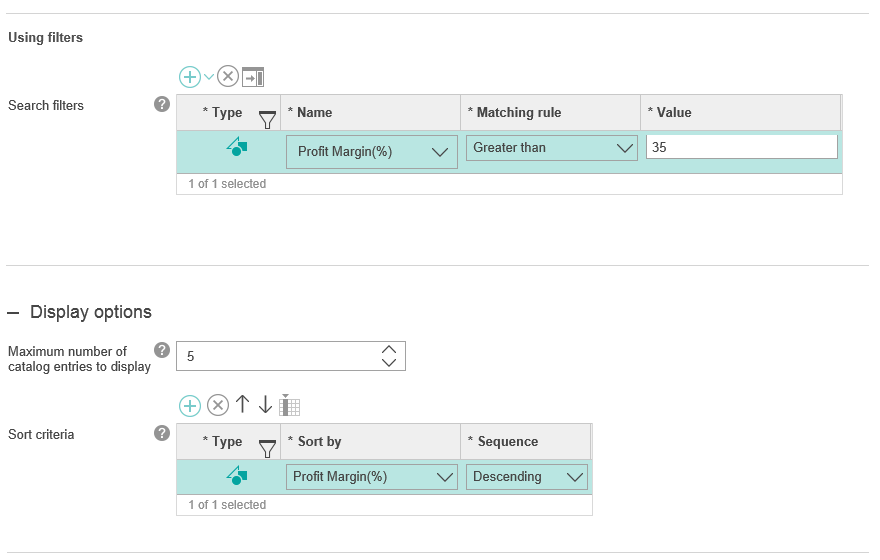Registering the new field in search tables
In this lesson, you register the profit margin field in the search tables with the proper property names. By registering the fields, the profit margin data displays as a filter name and sort criteria in product recommendations in the storefront.
About this task
In this lesson, a SRCHATTR_ID value of "10001" is used. All ID values that are
less that 10000 are reserved by WebSphere Commerce. If the value "10001" is
already used within your system, determine an available ID value for use in completing this
customization.
Note: This lesson provides a procedure that demonstrates how to register the search attribute by
using SQL statements. In this procedure, you must determine the SRCHATTR_ID for your SQL statements.
You can also register your new field using Data Load utility to load the data and register the
search attribute. By using the Data Load utility, the SRCHATTR_ID value is resolved for you. To
learn how search attributes are registered, it is recommended that you review and perform the SQL
procedure. If you are modifying the steps in this tutorial to create data that you are deploying to
your store and are registering many ID values, use the Data Load utility to prevent ID duplication
errors. To run the Data Load utility to load this data, you need to configure the utility to load
the sample data within the following compressed file: For more information about configuring and running the Data Load utility, see Configuring and running the Data Load utility. Ensure that you modify the
environment and database connection settings in the wc-dataload-env.xml
configuration file before your run the utility.
Procedure
-
Register the new indexed profit margin property within the SRCHATTR database
table by using the following SQL statement.
WhereINSERT INTO srchattr (SRCHATTR_ID, INDEXSCOPE, INDEXTYPE, IDENTIFIER) VALUES (10001, '0', 'CatalogEntry', '_cat.ProfitMargin');- The
"_cat"prefix in the value for the IDENTIFIER column indicates that the attribute is part of the catalog attribute. - The value for the IDENTIFIER column does not need to be the same as the index field. The value
should be meaningful to identify the attribute. In this tutorial,
ProfitMarginis used.
- The
-
Specify the usage and data type of the property within the SRCHATTRPROP table
by using the following SQL statement.
WhereINSERT INTO srchattrprop (SRCHATTR_ID, PROPERTYNAME, PROPERTYVALUE) VALUES (10001, 'merchandising-Filter-Numeric', 'profitMargin'); INSERT INTO srchattrprop (SRCHATTR_ID, PROPERTYNAME, PROPERTYVALUE) VALUES (10001, 'merchandising-Sort-Numeric', 'profitMargin');profitMarginis the example index field name that is used in this tutorial. Ensure that the PROPERTYVALUE matches the indexed field name that you defined when you updated your search x-schema.xml file.- The
'merchandising-Filter-Numeric'and'merchandising-Sort-Numeric'property names are included to identify profit margin as both a filter and sort criteria in product recommendations. For more information about the properties that you can use with WebSphere Commerce search and the usage of the properties, see Adding catalog entry properties to search rule actions or targets.
-
Specify the display name of the added indexed catalog entry property in the SRCHATTRDESC table by using the following SQL statement.
After you add these values, Management Center can displayINSERT INTO srchattrdesc (SRCHATTR_ID, LANGUAGE_ID, DISPLAYNAME, DESCRIPTION) VALUES (10001, -1, 'Profit Margin(%)', null);'Profit Margin(%)'as the label for the profit margin property when a user is working in the indicated language. You can add name for another language by using the similar SQL.For example, to add another language display value for the profit margin indexed catalog entry property, you can use an SQL statement that resembles the following statement:
WhereINSERT INTO srchattrdesc (SRCHATTR_ID, LANGUAGE_ID, DISPLAYNAME, DESCRIPTION, OPTCOUNTER) VALUES (10001, -2, 'translatedText', null, 0);translatedTextis the translated text for the property in the language that you want the property to display.
Results
The following image displays the Profit Margin(%) property label in the list of filter and sort criteria options.
